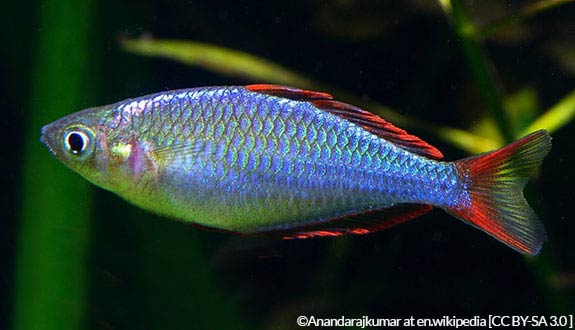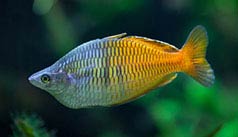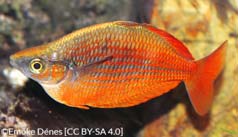

Alternative species (click on the thumbnail to see the card)
Names
Scientific name
Melanotaenia praecox
Rhombatractus praecox
Common name
Dwarf rainbowfish
Neon rainbowfish
Origin

Origin: Indonesia, New Guinea (Mamberamo river)
Biotope: Australia / New Guinea
Dimorphism
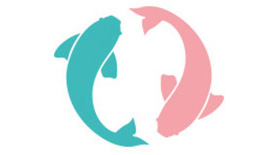
The male is more arched than the female, which is more streamlined. Their fins are reddish/orange, while those of the females are rather yellow. In general, they are also slightly more colourful.
Group
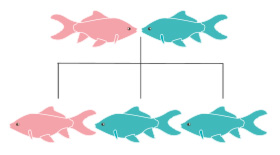
Melanoteniidae
Volume

150 L / 33 Imp Gal / 40 US Gal
Parameters

T°: 24 to 26°C or 75 to 79°F
pH: 6.5 to 7.2
Hardness: 10 to 15°dGH
Difficulty

Easy
Size

4 to 6cm (1.6 to 2.4")
Longevity

5 years
Living zone
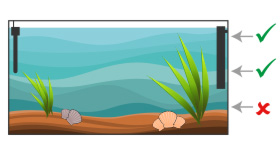
Middle and top
Individuals

6 to 8
Food
How to feed the Dwarf rainbowfish?
Food
How to feed the Dwarf rainbowfish?
Melanotaenia is an omnivorous fish with an insectivorous tendency and is easy to feed. Indeed, it accepts almost anything you offer it. It is particularly fond of live prey (mud worms, artemia...). Vary its meals for better health!
Behavior
What kind of behavior does the Dwarf rainbowfish have?
Behavior
What kind of behavior does the Dwarf rainbowfish have?
Very active and lively, making countless lengths in the open parts of the aquarium. Usually swims rather in a tight bank. He is sociable and peaceful.
Cohabitation
Who can live with the Dwarf rainbowfish?
Cohabitation
Who can live with the Dwarf rainbowfish?
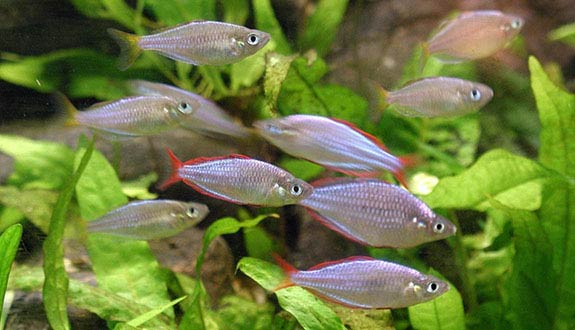
Melanotaenia are gregarious fish that require the presence of their congeners. To form your group, you can start with a ratio of one male to one female. Paradoxically, interspecific relationships are turbulent, and altercations are numerous but not serious: a hierarchy is established in all groups of Melanotaenia. However, note that, in general, most interspecific cohabitations go very well, both between males and females. Occasionally, some of the dominants may be a little too strong in character, even to the point of bullying the weaker ones. In this case, it will be necessary to have an aquarium with lots of space and many hiding places.
Very peaceful, it does not pose any particular problem of cohabitation with other species. For example, it can cohabit with other Melanotaeniidae with similar needs to its own. It is also possible to keep them together with bearded, danios, grouse or any other small fish that are quite sporty and that the Melanotaenia's stirring temperament will not disturb.
If you wish to breed "semi-natural", you will opt instead for a specific aquarium dedicated solely to this species.
Breeding
How to breed the Dwarf rainbowfish?
Breeding
How to breed the Dwarf rainbowfish?
Quite easy. You will easily recognize the fish ready to reproduce because they have an orange line running from the head to the dorsal fin. This line can be more or less pronounced depending on the individual.
Spawning usually takes place in the morning, almost daily throughout the breeding season. Courtship displays include speed chases, followed by dancing.
Recommended water parameters for reproduction are: temperature at 25°C (77°F), pH at 7 and hardness at 15°dGH.
In any case, you will need to prepare a small breeding aquarium. Be careful, its filtration must not be too powerful so that it does not suck up the fry. You can also protect your suction strainer.
Depending on the volume of the rearing aquarium, you can either isolate adults to spawn directly in it and then remove them afterwards. For smaller volumes, you can remove the plants on which the fish laid their eggs and place them in this aquarium. Be careful, the eggs are very small and difficult to see. In addition, Melanotaenias scatter their eggs. For example, they can lay their eggs directly on the ground, which makes the task of retrieving them more difficult. Last possibility, if your fish are in a specific aquarium, you can retrieve the fry that swim under the surface of the water in search of food to isolate them in the rearing tank.
The incubation of the eggs lasts from 10 to 15 days. At birth, the fry are extremely small (they don't even look like fish for that matter).
Feeding the fry: given their size, the difficulty will be to feed them. You can crush food until it is powdered (very fine flour) and offer it to the young. Parameciums and infusers are also on the menu. Once a little bigger, you can move on to artemia nauplias.
Its aquarium
Which aquarium for the Dwarf rainbowfish?
Its aquarium
Which aquarium for the Dwarf rainbowfish?
In its natural environment, this fish lives in clear, fast-flowing waters. This explains its lively and active temperament! It is therefore necessary to provide this species with a good swimming length. To do this, plan an aquarium that is at least one metre long. In addition, as far as filtration is concerned, you will need to choose a flow rate of at least 10 times the volume of the aquarium per hour in order to guarantee good water quality and a high oxygen level. You will then be close to natural water conditions.
Set up your aquarium with rocks and plants. Plant abundantly, but rather on the periphery of the tank (bottom and sides) to leave enough room for swimming. Floating plants will help to dim the lighting because this fish does not like bright light. Finally, a dark substrate will bring out their magnificent coloration.
Good To know
Find all additional information!
Good To know
Find all additional information!
Unfortunately, this fish is on the red list of endangered species in its natural environment.
It is quite sensitive to changes in water parameters.
Yours photos!

By Encyclo-Caro

By Encyclo-Caro
Comments
Sort by:
Please login to post comments
